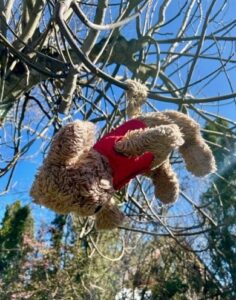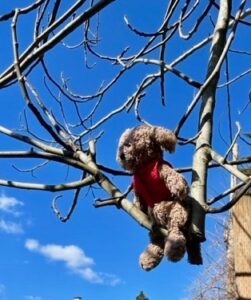
new world ponkey
I try not to fret, but for someone who has been diagnosed with eyeball fat and a lichenoid keratosis, I admit to feeling a little nervous when I first heard about ischial callosities. I was already wondering if I had any pedunculated papules. Sometimes those show up where you can’t see them, and I have lots of places like that, including 3/4 of my rear view plus some bits in front that I can only see if I lift the flappy stuff up first, and sometimes that’s just more bother than it’s worth, innit?
Anyway, turns out ischial callosities are pretty much a primate thing, but I’m not the right kind of primate. Still, we’re all brothers and sisters under the skin and you never know when something is going to develop that you have no underwear for. And I don’t like to be caught underwears.
I first heard about ischial callosities when I started looking into the difference between Old World Monkeys and New World Monkeys. Your correspondent needs to know how small a monkey can get if she is to properly convey the degree of difficulty involved in making off with a contraband primate in your pants. Why, it turns out there are monkeys small enough I could tuck them under those flappy bits that might be harboring pedunculated papules, and nobody would be the wiser. Seems to me, though, that you run a whole different risk in trousering very tiny monkeys, especially if they’re moved to seek shelter.
I guess all the New World monkeys floated over on rafts of vegetation from the Old World, long enough ago that they are quite different now. It’s a good reminder that if you find yourself on a raft of vegetation, snacking away or shooting the breeze, you should probably look up now and then to see if the shoreline is getting further away. The immigrant monkeys did all right for themselves though; some of them got prehensile tails, which was new, and helped them scamper around in tree canopies without falling off. The Old World monkeys have unfancy tails or none at all, and that’s where the ischial callosities come in handy.
“Callosity” derives from the Latin for “be hard,” which is exciting, and it’s related to “callus” and “callous.” Ischial callosities are hardened, thick, hairless pads on either side of an Old World monkey butt crack. Or, scientifically, “located bilaterally in the gluteal region.” Visualize a baboon and it’s probably the first thing you think of. I used to think they were all about sexual attraction. Otherwise why would you have a big, bulbous, brightly-colored region in the naughty zone? I would say I was not personally attracted to a baboon bottom but I’d be lying. You can’t look away from it.

old world ponkey
There is something to that, but the main reason to have thick hard butt pads in the first place is to allow yourself to sit comfortably on a tree branch without falling off. I am unclear if the entire apparatus is grippy.
Just as in other calluses, the skin becomes thickened due to repeated contact and friction. However, this process apparently occurs prenatally. I don’t know what the monkeys are doing in the womb to get their butt pads hardened, but they are monkeys. Anyway, if you want to catch a nap while sitting up high in a tree, they come in handy.
Probably protects against zipper abrasion, too.
I just snorted after the first paragraph. Haven’t even read the second one yet…
Emission accomplished.
I’m with you! I cracked up several times!
I was right back at the zoo, with a baboons butt, callused butt looking at me pressed up on the glass! Did I look away? Nooooo!
Still guffawing over not being able to look away from a baboon’s bottom. It’s working.
Supposedly a person is at risk of developing hemorrhoids if one is in the practice of sitting on concrete. That’s a whole nother form of display. Swelling and marking all in one package.
You really can’t not look.
Another issue to consider when trousering your monkey is whether or not it is housebroken.
Although if YOU’RE not housebroken it probably doesn’t matter much.
Ya had me a bit worried for you, for awhile there.
No pedunculated papules here. Maybe some reg’lar papules.
I understand calluses, my feet have plenty of them, but what on earth are pedunculated papules? They don’t sound like a fun thing to have. I always like seeing Pootie doing stuff.
He’s not a natural monkey as it turns out. Probably a bit afraid of heights. A pedunculated papule is a papule with a stem on it. Like a little mushroom. I don’t want extra things flapping below my flappers.
I had to immediately look up lichenoid keratosis. According to one source: “It’s most common in areas like your mouth, vagina, and other areas covered with skin.” I’m trying to figure out if I have any areas that are *not* covered with skin. Well, aside from eyeballs, that is. Have I overlooked some area of my body for all these years?
Your writing is truly a bright spot in my day. Except I just don’t want to think about monkey’s butts.
Yes you do. Anyway, thanks for the laugh. “Other areas covered with skin?” Lordy. Mine is on my forearm, in case you were busy visualizing something else. I picked at it the other day and the lichenoid part sort of came off and bled a lot. But it’s healed back up and the whole thing looks a little smaller. I have had it looked at by a derm: no problem.
Murr,
Four years of medical school, four years Pediatric internship/residency, eight years subspecialty training in Pediatric Pulmonology and then 30 years practice and not once have I ever come across the term ‘ischial callosities’. Obviously my education was a total waste. Thanks.
You shoulda been a biology major, like me!
Now you’ve got me thinking of the verse about baboons in the song “Cats on the Rooftops” (q.v.) (sung to the tune of “D’ye Ken John Peel”, iirc)
Well…I ken John Peel…don’t know the other.
You can hear one the many versions of it at https://www.youtube.com/watch?v=nlinEE3qy0I . I’m not sure you’d really want to, though.